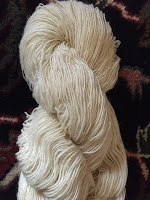 |
| Natural and dyed felted eye candy |
Interlocked threads transform to beautiful fabric
With a pile of roving in hand, why not needle felt it to make fabric? After our test drive on the felting machine, it was time for some production felting.As we would be renting the felting machine at an hourly rate, the plan was to prepare as much as possible at home and take them ready to feed into the machine. Using Coopworth roving, we cross-hatched roving to form what I'm calling pseudo-batts.
 |
| Layered roving prepped and ready to feed |
We had 11 of these batts in total and transported them without a hitch. Most of them were large and naturally colored pieces. Three used colored roving.
Getting the batts onto the bed of the felter sometimes required more than four hands, but, like the prep, it took doing it to figure out the best way to do it. Overall, they turned out exceedingly well and we're pleased with the results.
Or, I should say, Kris is pleased. They're from her flock and will be for sale at the upcoming Maryland Sheep & Wool Festival. She'll be at the American Coopworth Registry booth, a shepherds' co-op, in the auction tent area.
 |
| Blue-green felt comes off the machine |
But just because they're not mine doesn't stop me from thinking about what might I do with these pieces of felted wool. I can see embellishment--embroidery, felting, etc.--on the colored pieces, or maybe a hat. and the one with stripes? A hat.
As for the bigger pieces, I see vests and sweaters--maybe with knitted sleeves. Paint them to add color. Or not.
These are all blank slates ready for the creative fiber artist







